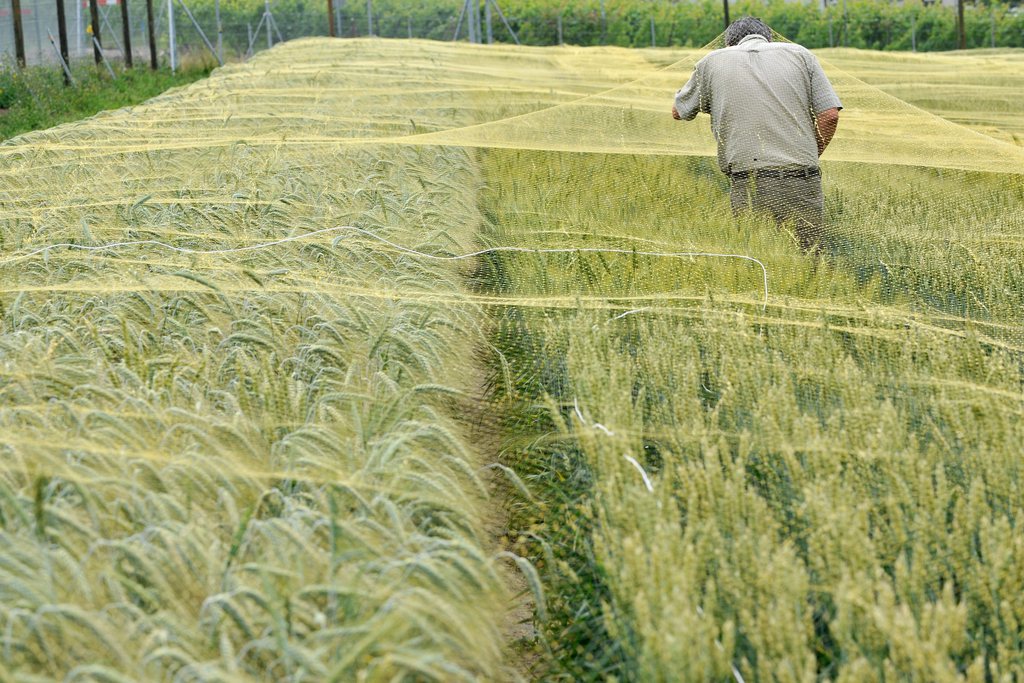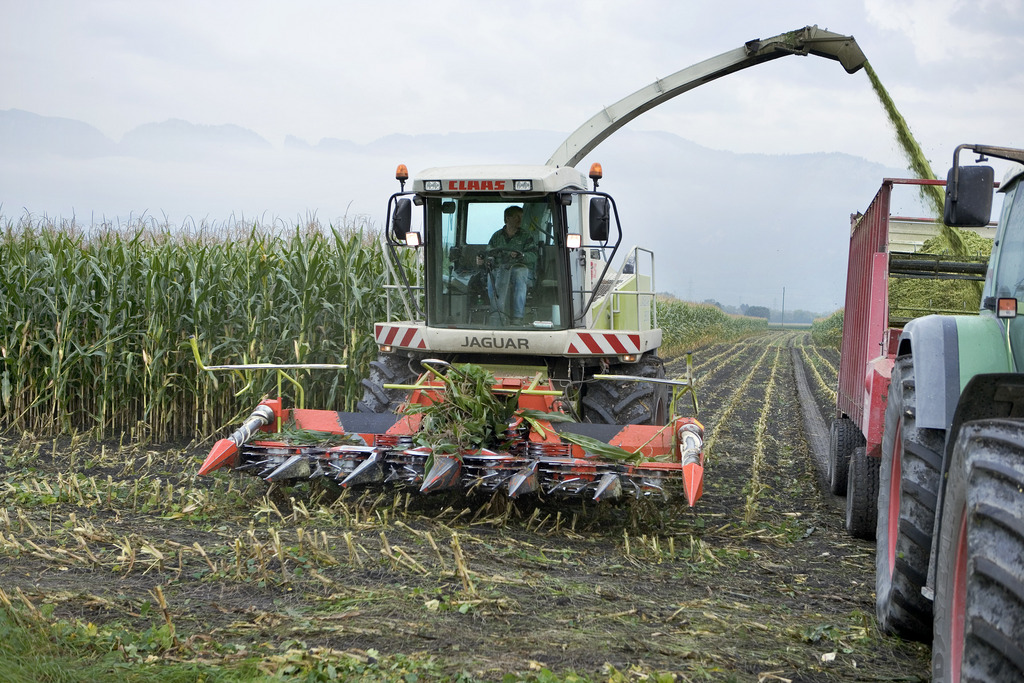Scientists’ findings don’t satisfy politicians

Banned from Switzerland until the end of 2013, genetically modified (GM) plants may now be out in the cold for another four years. Reassuring findings by scientists have not convinced politicians, farmers or environmentalists the plants are safe.
While they have been grown across the Americas and India for 15 years, GM plants for agriculture continue to be regarded with suspicion in Europe, nowhere more than in Switzerland. In 2005, Swiss voters approved a moratorium of five years on their use in the country. In 2010, parliament extended that ban by another three years.
Meanwhile, however, scientists commissioned by the federal government under the National Research Programme (NRP) 59 have been studying the risks and benefits involved in growing these plants derived from “green” genetic engineering. Initiated in 2005 along with the moratorium, the study’s findings were announced on August 28 of this year.
The findings are clear: the study found GM plants pose “no risk of any kind for health or the environment”.
Politicians remain wary
The final report of NRP 59 seems to be a green light from academia to politicians. However, as well documented as it is, the study seems to have little chance of being acted on in the foreseeable future. The day after the report’s release, the Zurich daily Tages-Anzeiger did a quick survey of leaders in parliament. Even those on the right favour extending the moratorium, though business is against it.
In February, farmer and parliamentarian Markus Ritter of the Christian Democrat party proposed a motion extending the current ban until 2017. A full 121 of his colleagues (out of 200) backed it, and the government is willing to accept it.
Ritter will be up for election to the Swiss Farmers’ Union on November 21. The majority of the union’s members are opposed to the use of GM plants, even if “it is not opposition in principle”, as Bernard Nicod-Etter, a member of the union’s executive committee, explains.
“Production of transgenic plants should fulfil three conditions: it should be make sense from an ecological, an agricultural and an economic point of view. Right now, none of these criteria hold,” he said.
Consumer surveys show that only a quarter of customers would be prepared to eat GM plants, but 80 per cent favour the freedom to choose between natural products and those produced by genetic engineering.
Environmentalists opposed
Greenpeace Switzerland reacted negatively to the findings of NRP 59, criticising the “absence of in-depth analysis of the risks of consuming genetically modified products to the health of man and animals”.
With regard to health issues, the Swiss scientists did not do their own research but reviewed the worldwide literature already in existence, over 1,000 studies in total. Greenpeace argues these studies lack the necessary time-depth because the repercussions on human health may be long-term. The group also questions the independence of these studies, which it says are often financed by industry interests, and is calling for an extension of the moratorium.
“This is not a ‘no’ in principle to any form of genetic engineering,” says Françoise Minarro, spokesperson for Greenpeace Switzerland. “We are in favour of research in restricted areas, for example for medical purposes. But industrial-scale cultivation will have completely different effects from these tests in the laboratory setting or in the open air on small patches of land. We simply want the principle of precaution to apply.”
Swissaid, the Swiss Foundation for Cooperation, has also advocated an extension of the ban. The group says GM plants only “aggravate the problem of world hunger”.
Survival of the fittest – or the most useful
Commercial GM plants produced by multinational companies like Monsanto and Syngenta have acquired a bad reputation. However, the Swiss scientists involved in NRP 59 didn’t buy seed from large distributors – all their supplies came from Swiss public or university laboratories.
Fabio Mascher of the Agroscope federal research station has worked with fields of genetically modified crops to test their resistance to certain types of fungus and look at the risks of dispersal into the surrounding environment. Creating GM plants is not part of Mascher’s usual job; with a PhD in phytopathology, he is a specialist in traditional methods of plant selection.
“Yes, the evolution of species is based, among other things, on genetic mutations,” he explains. “They are the motor of evolution. They create biodiversity. According to Darwinian theory, nature selects the fittest to survive. Traditional plant selection focuses on the most useful for man’s needs, which is not always the same thing.”
“But these needs are not purely commercial,” adds Mascher. “What counts is increasing the resistance to disease or the yield, to feed more people – the survival of our species, basically.”
Feeding more people was indeed an impetus to carry out NRP 59. However, politicians have yet to be convinced that this can be done without too many undesirable side-effects.
GM plants have a toxic effect on animals and possibly also on man, according to a study of the toxicity of transgenic maize and Roundup (a herbicide produced by Monsanto) which was carried out at the University of Caen, in France.
The study, published on September 19, 2012 in the online journal Food and Chemical Toxicology, studied a population of 200 rats over a period of two years.
Even in small doses, long-term exposure to NK603 transgenic maize and Roundup acts as a powerful, often lethal poison, said the author of the study, molecular biologist Gilles-Eric Séralini (who is also president of the scientific council of Criigen, an organization often critical of GM plants).
These findings, which have reignited the debate on GM plants in France, have been greeted with some skepticism in scientific circles. A number of researchers had concerns about the choice of the experimental animal, noting that they are usually prone to tumors. In addition, there was concern about a lack of precise information on the feeding of the animals and the statistical processing of the data gathered.
The European Commission has nonetheless asked the agency responsible for food safety to examine these research findings.
Ten thousand years ago, none of the plants or animals we eat now existed in their present form. In the time man has been engaged in agriculture and livestock-raising, he has been selecting species, keeping for reproduction the breeds and seeds that are most useful for his needs.
With genetic engineering, the business of selection takes on a new dimension. To improve the yield or resistance of a species, one or more genes from another plant or kind of bacteria can be grafted on to it. Thus, it becomes “transgenic”.
For example, Monsanto’s Bt maize and cotton are given a gene of a bacterium which naturally produces a protein poisonous to the larvae of insects that harm the plant. Thus, the plant now manufactures its own insecticide.
Nature, which evolves species by means of genetic mutations, can also on occasion produce “transgenic organisms”.
Researchers have found genes of bacteria present in plants and genes of plants in bacteria without any human intervention having taken place.
(Translated from French by Terence MacNamee)

In compliance with the JTI standards
More: SWI swissinfo.ch certified by the Journalism Trust Initiative











You can find an overview of ongoing debates with our journalists here . Please join us!
If you want to start a conversation about a topic raised in this article or want to report factual errors, email us at english@swissinfo.ch.